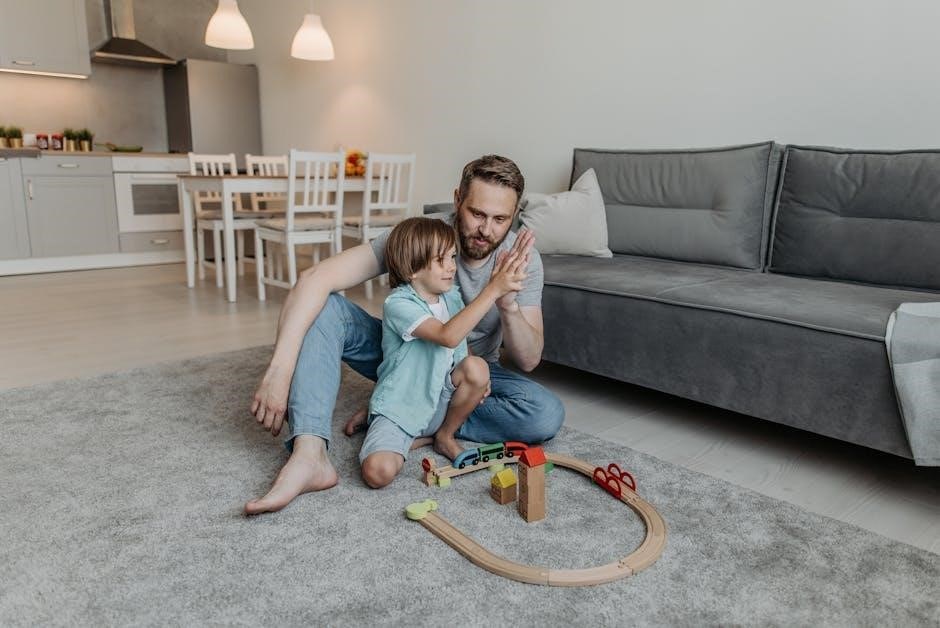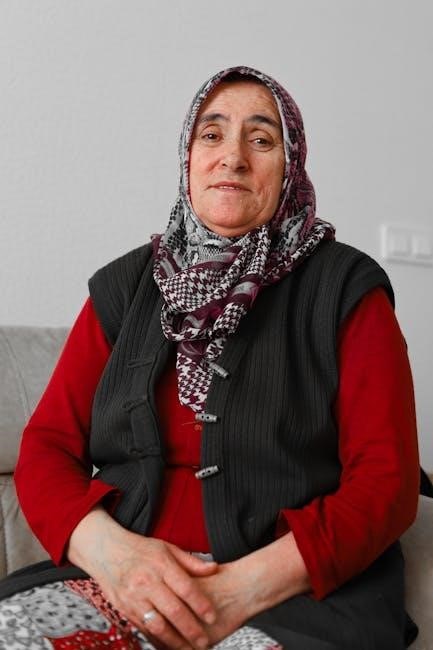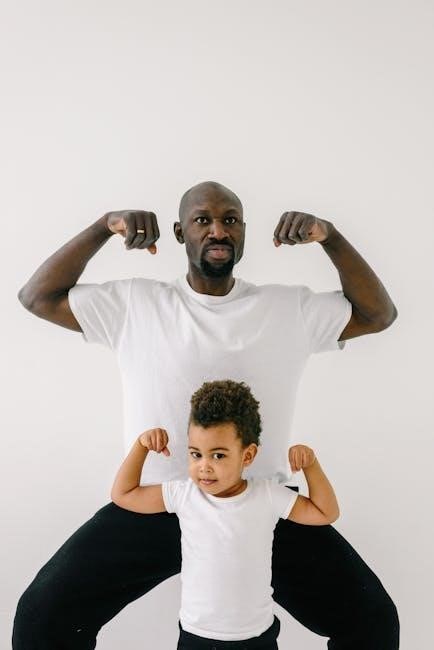Dysfunctional family roles are predictable patterns of behavior adopted by individuals to cope with underlying family issues, often stemming from trauma or dysfunction, impacting long-term well-being.
1.1 Definition and Overview
Dysfunctional family roles are predictable patterns of behavior individuals adopt to cope with underlying family issues, often rooted in trauma or systemic dysfunction. These roles, such as the Hero, Scapegoat, or Enabler, emerge as coping mechanisms to maintain balance in unstable households. They are shaped by family dynamics and can lead to emotional and psychological challenges. Understanding these roles is essential for addressing their impact and fostering healing. Dysfunctional roles often create a cycle of behavior that perpetuates imbalance and prevents healthy communication. Recognizing these patterns is the first step toward breaking free and rebuilding healthier family relationships. These roles are not innate but are developed as adaptive strategies in response to dysfunction.
1.2 Importance of Understanding Family Roles
Understanding dysfunctional family roles is crucial for recognizing patterns of behavior that perpetuate imbalance and emotional distress. These roles often dictate how individuals interact, cope, and express emotions within their family system. Without awareness, such patterns can lead to long-term psychological effects, strained relationships, and unresolved conflicts. Recognizing these roles helps individuals identify their own behaviors and how they contribute to family dynamics; This awareness is the first step toward breaking free from harmful cycles and fostering healthier communication. By understanding these roles, individuals can address root causes of dysfunction and work toward personal growth and more balanced family interactions. Awareness is key to healing and change.

Common Dysfunctional Family Roles
Common dysfunctional family roles include the Hero, Scapegoat, Enabler, Mascot, Lost Child, and Mastermind. Each role serves as a coping mechanism, shaping family dynamics and individual behaviors.
2.1 The Hero
The Hero is often the most responsible and high-achieving member of the family. They strive to maintain a perfect image to prove the family’s worth, masking underlying dysfunction. This role involves shouldering excessive burdens, such as excelling academically or socially, to gain approval. The Hero may suppress their own needs and emotions, leading to internal stress and resentment. Over time, this can result in burnout or feelings of inadequacy, despite outward success. The Hero’s role is both a coping mechanism and a source of silent suffering, highlighting the tension between maintaining appearances and addressing real family issues.
2.2 The Scapegoat
The Scapegoat is often the target of blame for the family’s problems, absorbing criticism and negative emotions. This role shifts focus away from the family’s real issues, making the Scapegoat a convenient outlet for frustration. They may be labeled as the “problem child” or the “troublemaker,” even if they are not the source of the dysfunction. Over time, this can lead to feelings of low self-worth, resentment, and alienation. The Scapegoat may act out to express suppressed emotions, further reinforcing their role. This dynamic prevents the family from addressing its deeper conflicts and fosters a cycle of blame and dysfunction.
2.3 The Enabler
The Enabler is a crucial figure in dysfunctional families, often unintentionally perpetuating harmful behaviors. They may cover up for others’ mistakes, make excuses, or provide emotional support that prevents individuals from facing consequences. While their actions seem helpful, they hinder accountability and growth. The Enabler’s behavior can stem from fear of conflict or a desire to keep the family stable. Over time, this role can lead to burnout and resentment, as the Enabler shoulders emotional burdens while neglecting their own needs. Their actions, though well-meaning, sustain the cycle of dysfunction, making it harder for family members to change or seek help.
2.4 The Mascot
The Mascot is the family member who often uses humor, charm, or cheerfulness to divert attention from the family’s dysfunction. They may hide their true feelings and struggles behind a carefree facade. This role can serve as a coping mechanism to avoid dealing with the family’s issues directly. While the Mascot’s behavior may bring temporary relief, it prevents the family from addressing deeper problems. Over time, this can lead to emotional suppression and a sense of disconnection. The Mascot’s role, though seemingly positive, can contribute to the perpetuation of dysfunction by maintaining a surface-level sense of normalcy. Their humor often masks underlying pain.
2.5 The Lost Child
The Lost Child is often the most invisible member of a dysfunctional family. They may withdraw from family interactions, becoming emotionally distant to avoid conflict or attention. This role emerges as a coping strategy, allowing the individual to survive by minimizing their presence. The Lost Child frequently feels neglected and misunderstood, as their needs and feelings are overlooked. Over time, this can lead to low self-esteem and difficulty forming healthy relationships. Despite their detachment, the Lost Child may struggle with deep-seated emotional pain, often requiring support to reconnect with their true self and develop a sense of belonging. Their silence can mask inner turmoil and unmet needs.
2.6 The Mastermind
The Mastermind is often the most manipulative and controlling member of a dysfunctional family. They may use charm, coercion, or even aggression to exert power over others. This role typically emerges in families where one member struggles with addiction or narcissistic tendencies. The Mastermind often orchestrates family dynamics to maintain their control, creating an environment of fear or dependency. Their behavior can lead to emotional turmoil for other family members, who may feel trapped or powerless. Over time, the Mastermind’s actions can escalate dysfunction, making it difficult for others to break free from their influence and establish healthy boundaries. Their control often perpetuates cycles of dysfunction.
Development of Dysfunctional Family Roles
Dysfunctional family roles often develop from unhealthy dynamics and unresolved trauma, emerging as coping mechanisms for underlying issues, which create imbalance and perpetuate family dysfunction over time.
3.1 Family Dynamics and Role Assignment
Dysfunctional family roles often emerge from unhealthy dynamics, where members unconsciously adopt specific roles to cope with underlying emotional conflicts or trauma. These roles, such as the Hero or Scapegoat, are typically assigned based on the family’s needs and can become rigid over time. The assignment may stem from subtle pressures or expectations, shaping how individuals behave and interact within the family system. These roles serve as coping mechanisms, providing a sense of order but perpetuating dysfunction. Awareness of these dynamics is crucial for understanding how roles develop and their impact on family relationships and individual well-being.
3.2 The Role of Trauma and Dysfunction
Trauma and dysfunction are central to the development of dysfunctional family roles, as they create emotional instability and force members to adopt coping mechanisms. These roles often emerge as a response to unaddressed trauma, such as addiction or abuse, which disrupts healthy communication and boundaries. The family system may become rigid, with roles like the Hero or Scapegoat emerging to manage the emotional turmoil. Trauma perpetuates dysfunction by reinforcing these roles, making it difficult for individuals to break free. Recognizing the link between trauma and role development is essential for understanding the root causes of dysfunction and the first step toward healing and change.

Impact on Individuals
Dysfunctional family roles take a profound emotional toll, often leading to anxiety, low self-esteem, and strained relationships, while also fostering self-sabotaging behaviors and limiting personal growth.
4.1 Emotional and Psychological Effects
Dysfunctional family roles often lead to profound emotional and psychological distress, including anxiety, depression, and low self-esteem. Individuals may struggle with self-worth, difficulty trusting others, and emotional regulation. The Hero may feel burdened by responsibility, while the Scapegoat may internalize guilt and shame. The Enabler often develops codependency issues, losing their sense of identity. Chronic stress from these dynamics can manifest as mental health disorders, strained relationships, and a pervasive sense of helplessness. These effects can persist into adulthood, affecting personal and professional lives if left unaddressed.
4.2 Long-Term Consequences
The long-term consequences of dysfunctional family roles can be deeply ingrained and far-reaching. Individuals may experience persistent emotional scars, difficulty forming healthy relationships, and a tendency to repeat harmful patterns. For instance, the Hero may struggle with perfectionism and burnout, while the Scapegoat might face chronic self-doubt and social isolation. These roles often lead to a lack of personal identity and autonomy, as individuals prioritize family dynamics over their own needs. Over time, this can result in unresolved trauma, mental health disorders, and a cycle of dysfunction that may extend to future generations if not addressed through therapy or self-awareness.

Healing and Moving Forward
Breaking free from dysfunctional roles requires self-awareness, therapy, and boundary-setting. Healing involves embracing personal identity, seeking support, and fostering healthy relationships to overcome long-standing emotional wounds.
5;1 Breaking Free from Dysfunctional Roles
Breaking free from dysfunctional roles involves recognizing the patterns and actively challenging them. Therapy, self-awareness, and boundary-setting are crucial steps. Individuals must identify how their role has shaped their behavior and emotions, then gradually step away from it. Support systems, such as counseling or support groups, can provide guidance and encouragement. It’s important to embrace personal identity and needs, rather than conforming to expected roles. Healing requires patience and courage, as it often involves confronting deeply ingrained habits and dynamics. By breaking free, individuals can develop healthier relationships and achieve emotional liberation from harmful family patterns.
5.2 Rebuilding Healthy Family Relationships
Rebuilding healthy family relationships requires effort, communication, and a willingness to change. Open dialogue about past hurts and unrealistic expectations can foster understanding. Setting clear boundaries helps establish respect and accountability. Seeking professional therapy or counseling can guide the process and provide tools for healthier interactions. Support groups can also offer a safe space to share experiences and learn from others. Patience is key, as healing is gradual. Encouraging individual growth and acknowledging each member’s needs can create a more balanced and supportive environment. Over time, consistent effort can transform dysfunctional patterns into a foundation of trust, empathy, and mutual respect.

Resources and Further Reading
Explore “Dysfunctional Family Roles PDF” for detailed insights into family dynamics. Visit this link to access comprehensive guides and research on the topic.
6.1 Recommended Literature and Studies
Key literature on dysfunctional family roles includes works by Virginia Satir, Claudia Black, and Sharon Wegscheider-Cruse, who pioneered research on family dynamics and roles. The Family Trap by Claudia Black and It Will Never Happen to Me by Sharon Wegscheider-Cruse are essential reads. These studies explore how roles like the Hero, Scapegoat, and Enabler develop and impact individuals. Additionally, Erik Bohlin’s work provides a detailed analysis of these roles. For further understanding, explore academic journals and recent studies on family systems theory and trauma recovery.
6.2 Where to Find “Dysfunctional Family Roles PDF”
Several resources offer PDFs on dysfunctional family roles. A notable source is Erik Bohlin’s PDF, which provides a comprehensive analysis. Additionally, academic platforms like Google Scholar and ResearchGate host numerous studies. Search for “dysfunctional family roles PDF” to find relevant materials. Websites specializing in family therapy, such as those by Claudia Black or Sharon Wegscheider-Cruse, may also offer downloadable resources. Ensure to verify the credibility of sources for accurate information.
